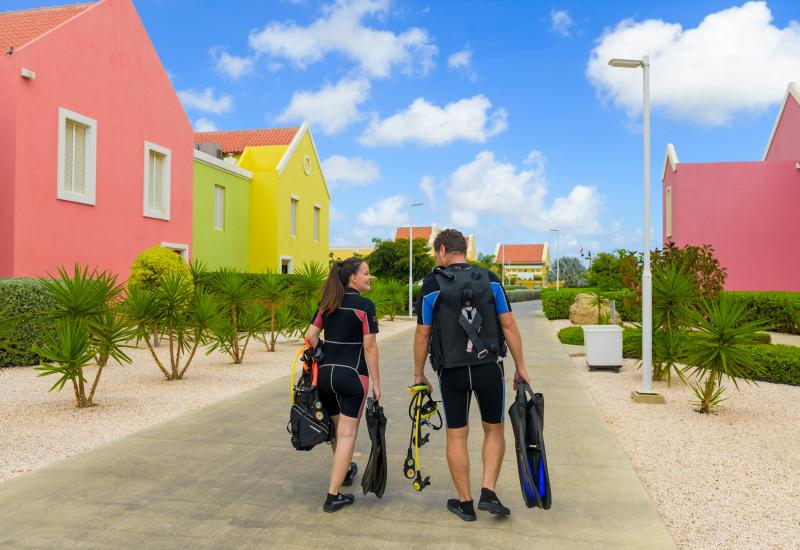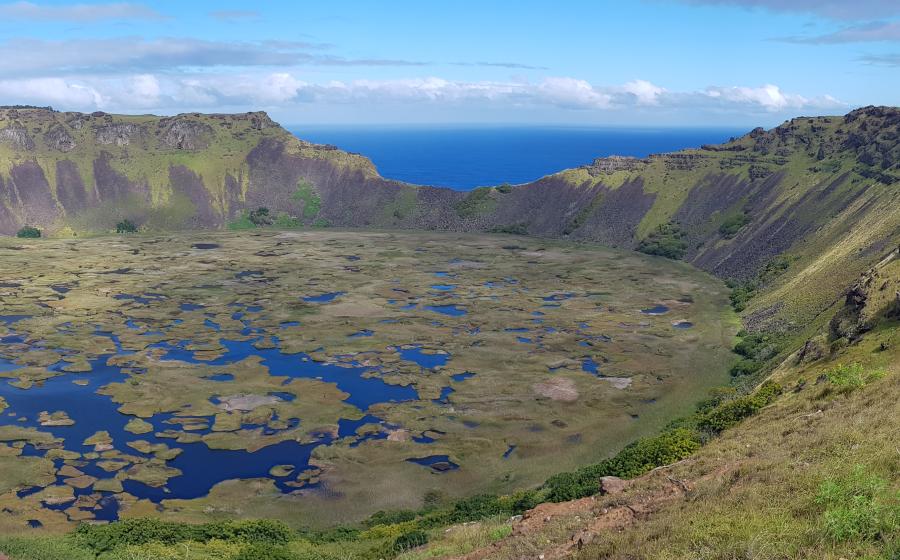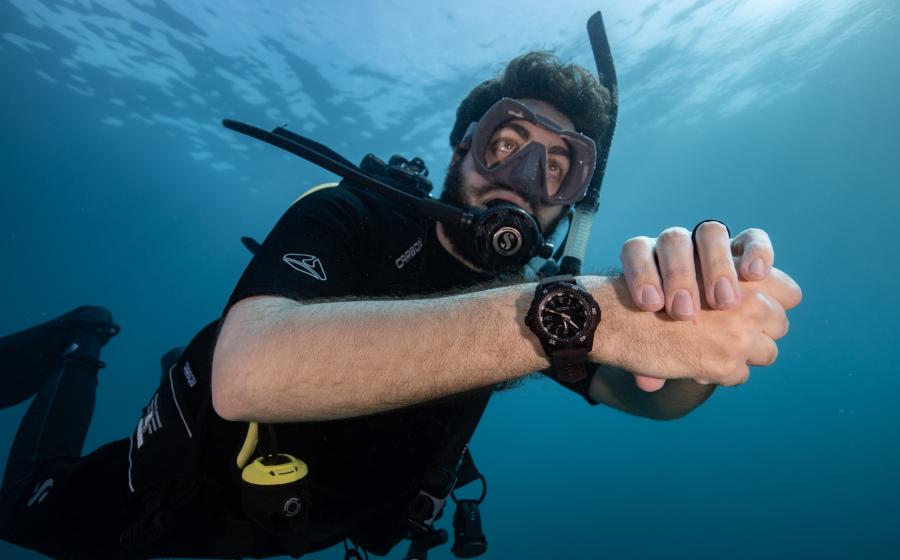The Live-aboard Experience
 One of the great joys of my diving career has been cruising the islands of the Bahamas on live-aboard dive boats. From the very first time I crossed the Gulf Stream to the Cay Sal Banks (in 1979 aboard a 50-foot dive boat from Key Largo), I realized this was a very special marine environment. This was the first place I ever saw water clarity in excess of 150 feet. The vertical walls, shark encounters, shipwrecks, and the wild dolphins of the Bahamas are all elements that define the greatest dive diversity in this hemisphere. The Bahamas by live-aboard is one of the world's most appealing dive adventures.
One of the great joys of my diving career has been cruising the islands of the Bahamas on live-aboard dive boats. From the very first time I crossed the Gulf Stream to the Cay Sal Banks (in 1979 aboard a 50-foot dive boat from Key Largo), I realized this was a very special marine environment. This was the first place I ever saw water clarity in excess of 150 feet. The vertical walls, shark encounters, shipwrecks, and the wild dolphins of the Bahamas are all elements that define the greatest dive diversity in this hemisphere. The Bahamas by live-aboard is one of the world's most appealing dive adventures.
For my style of diving and my photographic imperative, a live-aboard is perfect, but when diving the Bahamas, there are other very specific advantages to live-aboard cruising. One of the most significant is the sheer range of dive options available to the live-aboard that are simply beyond the reach of day boats. When you consider a destination that consists of 100,000 square miles of open ocean punctuated by 700 islands and 2,500 tiny cays, the cruising opportunities seem almost limitless. There are plenty of places to find sheltered anchorage for the night in proximity to awesome dives featuring pristine reefs, vertical drop-offs, shipwrecks, and high-voltage marine life encounters. Rarely are there long stretches of cruising between dive sites, and most itineraries include an appealing combination of dive and snorkel opportunities, beach excursions, and maybe even a semi-rowdy night ashore in a fascinating port of call like Bimini, Freeport, or Nassau.
 Why a live-aboard adventure? Some of the many draws to live-aboard diving include: cost; only unpacking once (this includes clothes and dive gear); more dives each day, if desired; more diving flexibility; generally smaller dive groups; less explored dive sites; onboard photography and video services; and advanced certification courses and other educational programs.
Why a live-aboard adventure? Some of the many draws to live-aboard diving include: cost; only unpacking once (this includes clothes and dive gear); more dives each day, if desired; more diving flexibility; generally smaller dive groups; less explored dive sites; onboard photography and video services; and advanced certification courses and other educational programs.
Like taking a cruise, the 'all-inclusive' cost of a live-aboard trip can generally be more economical than a land-based dive vacation. If you compare costs, the savings can (but won't always) include expenses for diving, food, beverages, and more. You only have to unpack once, even though you are visiting many places, and you don't have to lug your dive gear around each time you go diving.
One of the best reasons to try live-aboards is that they offer more diving each day. The average is typically four or five dives per day, but it's really up to the individual diver (given proper surface intervals, of course). If you really want to dive during your vacation, the sheer quantity of live-aboard diving is an advantage.
There's also great flexibility when it comes to live-aboard diving. If the conditions aren't good on one site, the ship simply changes locations. If the group tends to like diving on wrecks, and wrecks are available, that's where the live-aboard's diving can lean.
 The diving off live-aboards tends to be in smaller groups as well. This can be because the boat doesn't carry as many divers or it can be because they stagger divers, giving everyone a chance to explore the dive sites with just a few others.
The diving off live-aboards tends to be in smaller groups as well. This can be because the boat doesn't carry as many divers or it can be because they stagger divers, giving everyone a chance to explore the dive sites with just a few others.
Live-aboards also tend to offer less-explored diving. This is thanks to their ability to go (and stay) where land-based dive boats simply can't reach in reasonable times. And you sometimes go where few (if any) divers have ever been.
Many divers also seek to learn or expand their photography and video skills. Live-aboards typically offer full service to shooters, allowing participants to see their work and apply lessons to future dives (sometimes that same afternoon). In addition, on the learning front, advanced certification courses and other educational programs make live-aboards floating classrooms. It seems like the perfect environment to learn if, like many divers, you're ready to go back to school.
For details on some of my favorite Bahamas live-aboard expeditions, see
• Aqua Cat Trip Report
• Nekton Trip Report
• Blackbeard Trip Report
 One of the great joys of my diving career has been cruising the islands of the Bahamas on live-aboard dive boats. From the very first time I crossed the Gulf Stream to the Cay Sal Banks (in 1979 aboard a 50-foot dive boat from Key Largo), I realized this was a very special marine environment. This was the first place I ever saw water clarity in excess of 150 feet. The vertical walls, shark encounters, shipwrecks, and the wild dolphins of the Bahamas are all elements that define the greatest dive diversity in this hemisphere. The Bahamas by live-aboard is one of the world's most appealing dive adventures.
One of the great joys of my diving career has been cruising the islands of the Bahamas on live-aboard dive boats. From the very first time I crossed the Gulf Stream to the Cay Sal Banks (in 1979 aboard a 50-foot dive boat from Key Largo), I realized this was a very special marine environment. This was the first place I ever saw water clarity in excess of 150 feet. The vertical walls, shark encounters, shipwrecks, and the wild dolphins of the Bahamas are all elements that define the greatest dive diversity in this hemisphere. The Bahamas by live-aboard is one of the world's most appealing dive adventures.
For my style of diving and my photographic imperative, a live-aboard is perfect, but when diving the Bahamas, there are other very specific advantages to live-aboard cruising. One of the most significant is the sheer range of dive options available to the live-aboard that are simply beyond the reach of day boats. When you consider a destination that consists of 100,000 square miles of open ocean punctuated by 700 islands and 2,500 tiny cays, the cruising opportunities seem almost limitless. There are plenty of places to find sheltered anchorage for the night in proximity to awesome dives featuring pristine reefs, vertical drop-offs, shipwrecks, and high-voltage marine life encounters. Rarely are there long stretches of cruising between dive sites, and most itineraries include an appealing combination of dive and snorkel opportunities, beach excursions, and maybe even a semi-rowdy night ashore in a fascinating port of call like Bimini, Freeport, or Nassau.
 Why a live-aboard adventure? Some of the many draws to live-aboard diving include: cost; only unpacking once (this includes clothes and dive gear); more dives each day, if desired; more diving flexibility; generally smaller dive groups; less explored dive sites; onboard photography and video services; and advanced certification courses and other educational programs.
Why a live-aboard adventure? Some of the many draws to live-aboard diving include: cost; only unpacking once (this includes clothes and dive gear); more dives each day, if desired; more diving flexibility; generally smaller dive groups; less explored dive sites; onboard photography and video services; and advanced certification courses and other educational programs.
Like taking a cruise, the 'all-inclusive' cost of a live-aboard trip can generally be more economical than a land-based dive vacation. If you compare costs, the savings can (but won't always) include expenses for diving, food, beverages, and more. You only have to unpack once, even though you are visiting many places, and you don't have to lug your dive gear around each time you go diving.
One of the best reasons to try live-aboards is that they offer more diving each day. The average is typically four or five dives per day, but it's really up to the individual diver (given proper surface intervals, of course). If you really want to dive during your vacation, the sheer quantity of live-aboard diving is an advantage.
There's also great flexibility when it comes to live-aboard diving. If the conditions aren't good on one site, the ship simply changes locations. If the group tends to like diving on wrecks, and wrecks are available, that's where the live-aboard's diving can lean.
 The diving off live-aboards tends to be in smaller groups as well. This can be because the boat doesn't carry as many divers or it can be because they stagger divers, giving everyone a chance to explore the dive sites with just a few others.
The diving off live-aboards tends to be in smaller groups as well. This can be because the boat doesn't carry as many divers or it can be because they stagger divers, giving everyone a chance to explore the dive sites with just a few others.
Live-aboards also tend to offer less-explored diving. This is thanks to their ability to go (and stay) where land-based dive boats simply can't reach in reasonable times. And you sometimes go where few (if any) divers have ever been.
Many divers also seek to learn or expand their photography and video skills. Live-aboards typically offer full service to shooters, allowing participants to see their work and apply lessons to future dives (sometimes that same afternoon). In addition, on the learning front, advanced certification courses and other educational programs make live-aboards floating classrooms. It seems like the perfect environment to learn if, like many divers, you're ready to go back to school.
For details on some of my favorite Bahamas live-aboard expeditions, see
• Aqua Cat Trip Report
• Nekton Trip Report
• Blackbeard Trip Report










